The Nexus 6 Review
by Brandon Chester on November 12, 2014 1:00 PM ESTDisplay
The display is one of the most important aspects of a smartphone, as it is the part of the device that the user will interact with most. We've seen tremendous improvement in smartphone displays as they have become more and more commonplace within society. The first area of improvement was resolution, which made sense with text being a necessary part of essentially every smartphone application. As displays have gotten to the point where there is little benefit to further increasing pixel density, we have also seen a push for greater color accuracy and image rendition. On the Android side of the market, Google was one of the first companies to start taking color accuracy seriously, and the Nexus 7 and Nexus 5 had some of the best calibrated displays of all Android devices.
The Nexus 6 sports a 5.96" AMOLED display with a resolution of 2560x1440. Given Google's work to provide accurate color calibration on the Nexus 5, and the massive improvements that we've seen in the calibration of AMOLED displays over the course the past year, I was very excited to take a look at the display on the Nexus 6. However, as someone who typically uses the very well calibrated iPhone 6 and Nexus 5 in daily use, I immediately noticed that the Nexus 6 produced a punchier image than I was used to seeing in the applications I use frequently.
To take a look at the characteristics of the Nexus 6's display we turn to SpectraCal's CalMAN 5 software and an X-Rite i1 Pro 2 spectrophotometer for accurate measurements of the display's color. As always, we target the sRGB gamut which is currently the standard for photos on the web and video content.
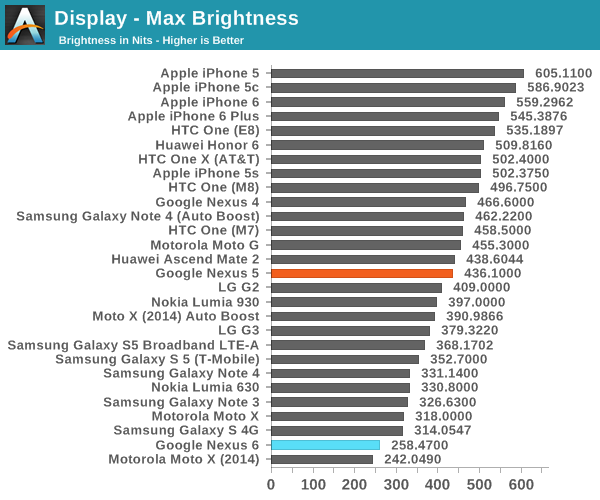
Contrast and black levels on the Nexus 6 are as incredible as ever. Brightness is definitely on the low side though. Testing was performed with both the manual brightness settings, and with Adaptive Brightness enabled and a bright LED aimed at the light sensor. In both cases the maximum brightness was the same, there's no higher brightness exposed when using the automatic brightness settings like there is for the Galaxy Note 4. What's interesting to note is that the brightness is similar to that of the 2014 Moto X, another recently released Motorola device that sports an AMOLED panel. However, even Moto X has an auto boost mode which pushes it up to 390nits. The overall similarity between the panel in the Moto X and the panel in the Nexus 6 persists throughout our other tests.
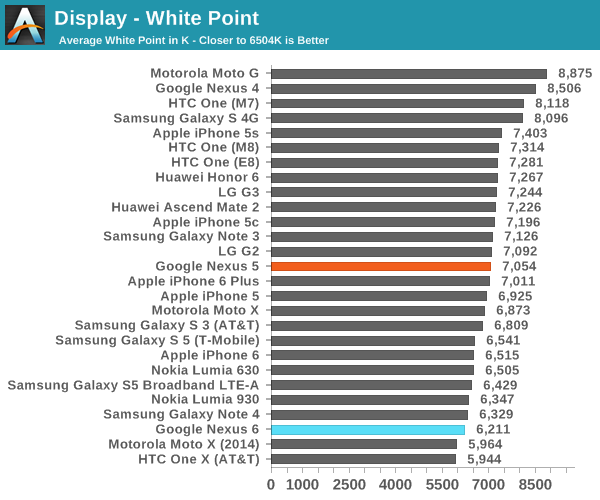
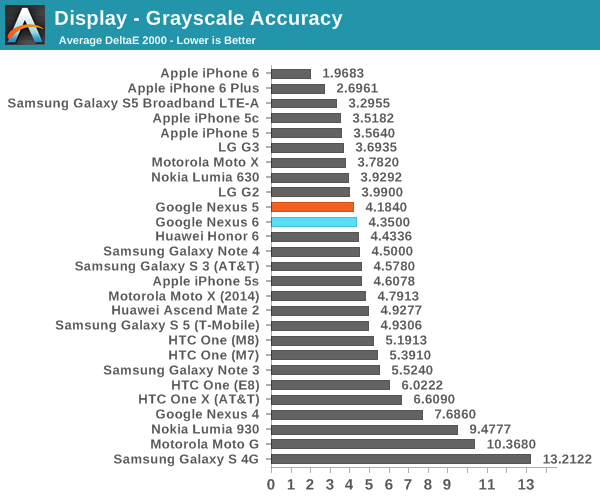
The Nexus 6 is slightly more red than our target for white point, though not to the extent of the 2014 Moto X. This contrasts with the IPS panel in the Nexus 5 which was too blue. In the greyscale we see that the luminance is comprised more of red and green than of blue. This translates to greyscale performance that is nothing exceptional, but not noticably worse than the Nexus 5, and still significantly improved compared to AMOLED panels from not long ago like the display in the Galaxy Note 3.
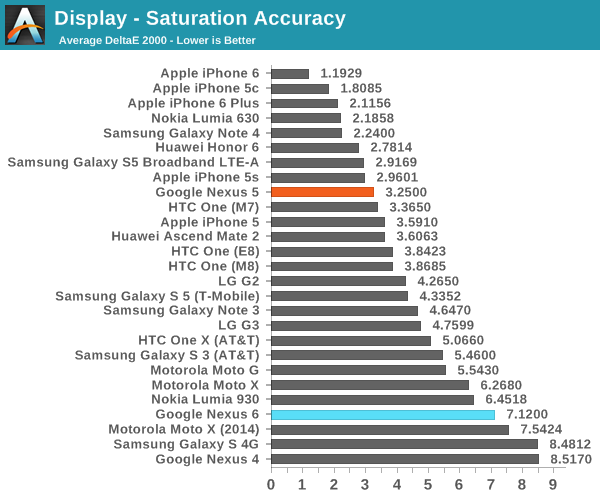
In our saturation sweep test, the Nexus 6 performs rather poorly. Unlike Samsung's phones which have several display modes with one of them targeting sRGB, the Nexus 6 has only one display setting and it significantly overshoots the sRGB gamut. This does a good job at creating showroom appeal but is not helpful in accurately displaying the color in photos and videos. This is especially disappointing because the Nexus 5 was well calibrated to sRGB and performed much better in this test.
The poor performance in the saturation sweep translates to equally poor performance on the ColorChecker test. The expanded gamut and saturation compression makes it effectively impossible for this display to render any sRGB content accurately. The greyscale performance helps to bring down the overall average, but the large errors with color mixtures prevent any sort of accurate image rendition.
I was highly disappointed by these results. Like I said earlier, we've seen great improvements in the quality of AMOLED displays as of late, and Google took color calibration very seriously with the Nexus 5. The Nexus 6 shows significant regression in color accuracy from the Nexus 5, and the maximum brightness is much lower. It should also be noted that despite its higher resolution, its larger size means that compared to the Nexus 5 the pixel density only increases 12% from 441 PPI to 493 PPI. The use of a PenTile RGBG subpixel layout also means that there is actually an overall decrease in subpixel density.
Overall, the Nexus 6 display is quite poor relative to the displays on other smartphones like the Galaxy Note 4, iPhone 6, and HTC One (M7). It's also a definite regression from the display on the Nexus 5, which is concerning given the fact that the Nexus 6 is $300 more expensive. It has been speculated that Motorola is unable to source the latest generation of panels from Samsung Display, which would explain why many of the panel characteristics are similar to previous generation AMOLED panels in the Note 3 and Galaxy S4. Although the efficiency of AMOLED displays when displaying black helps to reduce power usage with features like Ambient Display which wakes up the phone when notifications arrive or it is picked up, I don't believe it's worth the trade-off if it involves such heavy sacrifices in color accuracy and brightness.


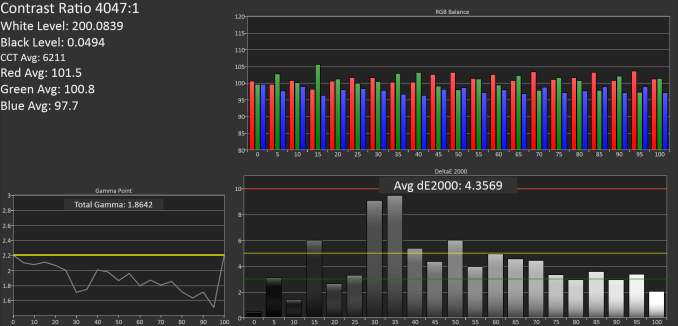
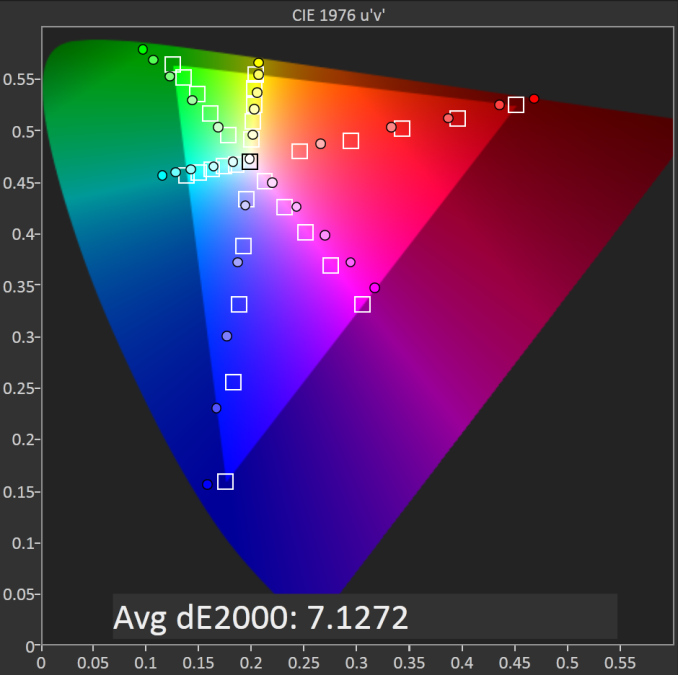









136 Comments
View All Comments
tuxRoller - Wednesday, November 12, 2014 - link
Google really screwed up this years nexus devices.They are what I always buy, so now I'm left in a bit of a lurch.
Probably will wait for the 64bit transition next (snapdragon 810, or exynos 7, though I'd prefer to avoid img gpus).
hpglow - Wednesday, November 12, 2014 - link
I'm a little taken back by the poor battery life compared to the note 4. The screen is a little larger but damn.modulusshift - Wednesday, November 12, 2014 - link
Hey, can we please get a storage benchmark on this? Ars claims it has big problems, is that a memory supplier issue? Thank you!jaysns - Wednesday, November 12, 2014 - link
Apparently there is a huge performance hit when switching on encryption on the Nexus 5 http://www.reddit.com/r/nexus6/comments/2m4jra/une...Can only hope this is a bug as this will pretty dramatically affect how the device performs.
1032724311 - Wednesday, November 12, 2014 - link
系统还是原来是原生系统 可终端设备已经不是原来的nexus的味道了spikebike - Thursday, November 13, 2014 - link
So for twice the money (or so) of the nexus 5 we get a phone that loses many benchmarks (battery life, cpu, brightness, saturation) to the nexus 5. What's worse is that the nexus 5 was already trailing in battery life to begin with.Here's hoping google adopts some of the better phones into the GPE program.
Nevod - Thursday, November 13, 2014 - link
What seems to be most strange is the really poor battery life. Note 4 has just a bit smaller screen (10% difference only) yet more than 50% longer life. The cause isn't obvious, they both have AMOLED screens of same resolution, exactly same battery capacity and similar performance. The only differences are SoC (I get that it's the most important thing, but modern SoCs aren't that different in efficiency IIRC) and perhaps screen quality. When Galaxy Nexus came out, it had screen ahead of everyone else - but it was immature and extremely power hungry, paired with an already outdated SoC which GPU was overloaded with screen's resolution it had really poor battery life in browsing. Displays advanced and soon even screens with much smaller pitch were more efficient, processes shrank and GPUs consumed modest power on higher resolutions.Here, however, everything is nearly identical to Note 4. What is the cause of such a difference? Is the screen on N6 really is such a power hog (who's the supplier, anyway? Samsung, I suppose?). Though even the screen itself shouldn't be so problematic. Is the Exynos, and Mali in particular so much more efficient? Unlikely. I do think that this is caused by software, as seemingly it was with most Nexus phones - they were never really good at battery life. Even the Lollipop doesn't seem to help that.
darkich - Thursday, November 13, 2014 - link
Yeah,on top of all that, Lollipop is said to make HUGE power efficiency gains over KitKat.So this story is a major upset to some MYTHS.
What happened with pure, clean Android (supposedly more efficient), and the bloated, messy Samsung ROM (supposedly less efficient)?
If the myths are true, Note 4 with Lollipop should have ridiculously better efficiency than this, on basically equal hardware.
darkich - Thursday, November 13, 2014 - link
Oh and btw, the Samsung Note 4 ROM is vastly better than this.Besides offering the richest possible multitasking options, and all the S Pen extras, it actually makes one handed use easily possible.
This aspect keeps on getting ignored in the reviews just because reviewers arent even thinking about using it.
I ignored the one handed option too for months on my Note 3, but slowly it sank in, and now I see it as an essential piece of any proper phablet software.
Nevod - Thursday, November 13, 2014 - link
I've re-read battery and display parts of Nexus 6 and Note 4 reviews and now I think I do get it. Looks like Nexus 6 indeed has a problematic screen, like the Galaxy Nexus had before - it has way too high power consumption and low max brightness. However, that by itself shouldn't cause too much of a problem in real use (unless you are typically browsing in direct sunlight).Battery life test is done at 200 nits, almost the max of 250 nits for Nexus 6. GNex at that brightness level had some serious power consumption from display alone, well over 1 watt, so screen's power consumption dominates the test done like that. IRL, you don't just load the page over and over, with modest CPU and GPU load, you actually scroll a lot, seriously loading GPU - you actually scroll way more than you do anything else, so RL web browsing life is dominated by GPU power consumption, as the screen is usually running at low brightness level and it's contribution to power consumption isn't that big.
So, I suppose, while for sure Nexus 6 will have less battery life than Note 4 due to crappy screen tech, in real life, there shouldn't be too much of a difference, probably around 10%, 15% at most.